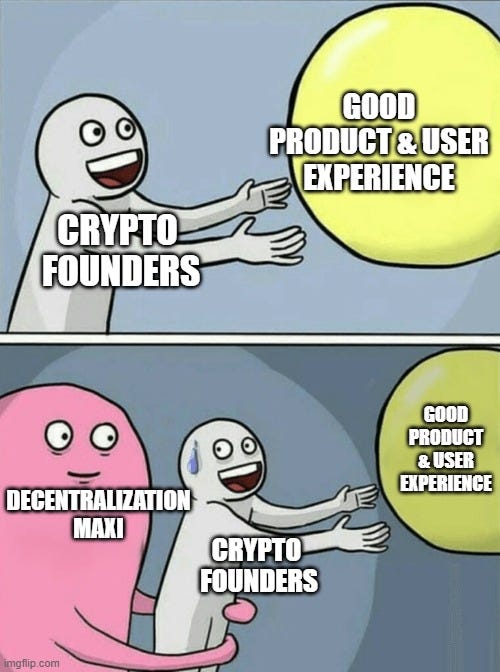Crypto Vertical Integration
The killer dApps will most likely be centralized.
Disclaimer, NFA, all that legal stuff: All the information presented on this publication and its affiliates is strictly for educational purposes only. It should not be construed or taken as financial, legal, investment, or any other form of advice.
Hi folks,
The crypto space is full of young people that have strong opinions and are often blinded by ideologies that are not always predicated on realities. As the industry matures, the battle between differing ideologies within the crypto space itself will become much more complex. In this write-up, I cover how crypto networks and protocols can benefit from vertical integration, a common concept in business; but might cause a dilemma for those upholding the decentralization ethos to the fullest.
Crypto Vertical Integration
The Macalinao brothers had the right idea but the wrong approach.
For the uninitiated, the Macalinao brothers were known for “faking” a DeFi ecosystem in the Solana blockchain. The brothers launched multiple Solana projects under 11 different aliases, falsely creating the perception that the Solana DeFi ecosystem was thriving when in fact the majority of the Total Value Locked (TVL) was double-counted by re-using collateral across the different protocols that they’ve built. At its peak, the brothers were estimated to be responsible for 70% of Solana’s DeFi TVL ($7.5 billion out of $10.5 billion); its rehypothecation on steroids.
At a glance, what the brothers did look like a grift. While that’s more or less true, there are learnings to be made from their actions. They had the right idea in mind, but opt-in for short-term profits instead of building their credibilities over the long run — but hey, grifters in crypto are often forgiven, so maybe they were smart indeed.
What the brothers did was essentially vertical integration. A “boring” business concept that has existed for decades, taught in business schools and implemented not only by your web 2.0 tech giants but also by your medium-sized conventional family businesses. In layman's terms, it means combining multiple aspects of the business’ supply chain under one roof, overseeing your end-user experience as much as possible.
User experience is one of the biggest bottlenecks in crypto. Your average 20-30 year old still thinks that crypto is confusing, even if they’re working in big tech. If we can’t even easily onboard young educated individuals, how can we expect crypto to reach mainstream adoption? I mean true adoptions where your everyday app runs on the blockchain and is powered by token, not the buy-doge-on-Robinhood type of “adoption”.
It makes perfect sense for dApps to vertically integrate, stacking on top of one another to create an ecosystem that focuses on user experience. I don’t want to use multiple hot wallets, on multiple L1 chains, to try multiple products. Those of us who work in crypto and are early to these technologies might enjoy that, but most people just want a seamless product experience that they’re currently getting from the incumbents’ web 2.0 apps.
So how can crypto solves this problem and vertically integrate to offer better products and experiences while maintaining decentralization? Let’s get into it.
Here are the quick takeaways:
Centralized players in the crypto space are already doing this.
Execution matters more than innovations in an open-sourced and fork-able industry.
Products that are closest to the end users have the most valuable currency and the highest potential to vertically integrate.
Vertically integrating removes the need for external composability that can introduce additional risks.
The underlying technology might be decentralized, but in near future, the killer products will be centralized.
New Technologies, Same Old Playbook
All of the big crypto centralized players have been doing vertical integration for years. Think acquisitions, a new product launch that copies existing companies, and many more. We’re lucky that despite the size and influence of the likes of Binance, FTX, and Coinbase, the on-chain ecosystem is still ripe for builders and innovators. Relatively new players such as Lido and Frax were able to enter the scene and found product-market fit without getting trampled by these crypto giants.
That said, large CEXs have been increasing their on-chain initiatives for the last few years. FTX has Solana and Serum, Binance has the BNB chain and Trust Wallet, and Coinbase is ramping up dApps integration for its non-custodial wallet. These giants have close to unlimited funds and should be able to easily copy any open-sourced on-chain products.
So the question becomes: is there room for on-chain products to vertically integrate and compete with these giants?
Imagine a World
There are two crucial factors that can make or break on-chain products’ efforts in vertically integrating and competing against the incumbent CEXs.
USERS
The on-chain players with the most valuable currency are those who are closest to the end-users. It is much easier to move from Uniswap to Sushiswap than from MetaMask to Rainbow. Non-custodial wallets are arguably the most poised to capitalize on the vertical integration trend and create products that will lock users in its ecosystem, similar to how the CEXs have been doing it.
MetaMask made more than $350M in revenue from its in-app “swap” feature, basically Laziness as a Service. Users can easily go to Uniswap to trade, but a lot of them chose to do so within the MetaMask app. Imagine if MetaMask launches its own AMM with concentrated liquidity, becomes its own LP Lfinity-style, and charges cheaper fees for the most popular pairs (ETH/USDC). What if they also decide to launch on-chain earn products or even a stablecoin?
 Laziness as a Service is how MetaMask has earned $350mm+ in the last 12 months.Let’s put these numbers into perspective. In just over a year Swaps has 1,229,857 users with $20B in total volume. For every $1000 traded Metamask earns $8.75 Sushi earns $0.5 Curve earns $0.2 The combined revenue of Sushi & Curve this year is not even half of MetaMask’s. https://t.co/pEN3PaNQMt
Laziness as a Service is how MetaMask has earned $350mm+ in the last 12 months.Let’s put these numbers into perspective. In just over a year Swaps has 1,229,857 users with $20B in total volume. For every $1000 traded Metamask earns $8.75 Sushi earns $0.5 Curve earns $0.2 The combined revenue of Sushi & Curve this year is not even half of MetaMask’s. https://t.co/pEN3PaNQMt 👨🍳.eth @CroissantEth
👨🍳.eth @CroissantEth
EXECUTION
The Macalinao brothers’ action in Solana DeFi was the largest elephant in the room for the longest time. Almost all other Solana founders were aware of it, but somewhat helpless to act given the speed of execution that the brothers deployed. It’s actually commendable.
In an open-sourced world where protocols are fork-able, having great executions matters more than finding new innovations. It’s not that we should disregard founders that want to try novel ideas, but we should also take into consideration how fast can those founders execute , and whether the ideas are defensible.
Daniele Sesta tried to create such an ecosystem (although without the wallet component) by combining SUSHI-TIME-POPSICLE-ABRACADABRA, which in retrospect could have been successful if it’s not for the downfall of TIME. Fast execution matters. For a second, it felt like his DeFi ecosystem could’ve overtaken or competed on the same level with the OG DeFi protocols. His mistake was going too fast and underestimating the risks associated with TIME.
Imagine a world with the following MetaMask ecosystem where it owns everything:
In essence, vertically integrating removes the need for external composability that can introduce additional risks. It also means that protocols can move faster. To convince MakerDAO to accept yield-bearing assets as collateral, there are politics and governance procedures that need to take place; but if you make a similar protocol yourself (Abracadabra), you can quickly add new types of collateral and create degen strategies. You can think that these degen products are bad, but it was still a new product innovation with real customer demands.
In fact, major protocols and dApps are already realizing the benefits of vertical integration. AAVE with GHO, NEAR with USN, and many more. In my day job, we have written a report about the state of play for stablecoins and the rise of protocol-owned stablecoins.
If You Want to Go Fast, Go Alone. If You Want to Go Far, Go Together.
The counterargument to this is the African proverb you just read above. A team that is focused on one product will most likely generate a higher quality outcome in the long run. They will pay attention to every little detail and be more careful with security risks.


However, I would argue that the benefits of going together are much less impactful in crypto. For non-crypto businesses, you can protect your hard work via patent laws or even geographical advantage. For on-chain products, everything is digital. There is no law that can properly protect your unique innovation nor do you have any geographical advantage. The winning team will go fast, finding the right balance between execution and measured security practices.
But Then It’s All Centralized!
Well, that depends, but first and foremost, I welcome you back to reality. Every successful product and company for the past few centuries has been centralized powers. They were eventually broken up by the governments for the benefits of the free market and to instigate innovations, but everything from chicken producers to big tech and finance is centralized power. By combining everything under one roof, they offer an experience that is unmatched by their competitors.
If governance token truly has full governance rights as the industry matures, then the crypto space at least allows market participants to own these products from the get-go instead of waiting for them to go public first. The underlying technology (the blockchain) might be decentralized, but it is far more likely for the killer dApps to be centralized powers.
Ludicrous
Adam Neumann raised $350M from a16z for his new real-estate venture, Flow. Not the Flowcarbon tokenized carbon credit project he’s involved with, nor the Flow blockchain. A spin-up of the old WeWork’s communal living initiatives from a founder that became a billionaire after destroying tens of billions in value for his investors and employees, received the largest ever check that a16z has ever written. While from a return perspective this investment can actually work (I won’t bother with the calculation here), a16z shows that you can destroy decades-long of reputation building within a few years by being a money-driven NIMBY.
Until next time,
Marco M.






